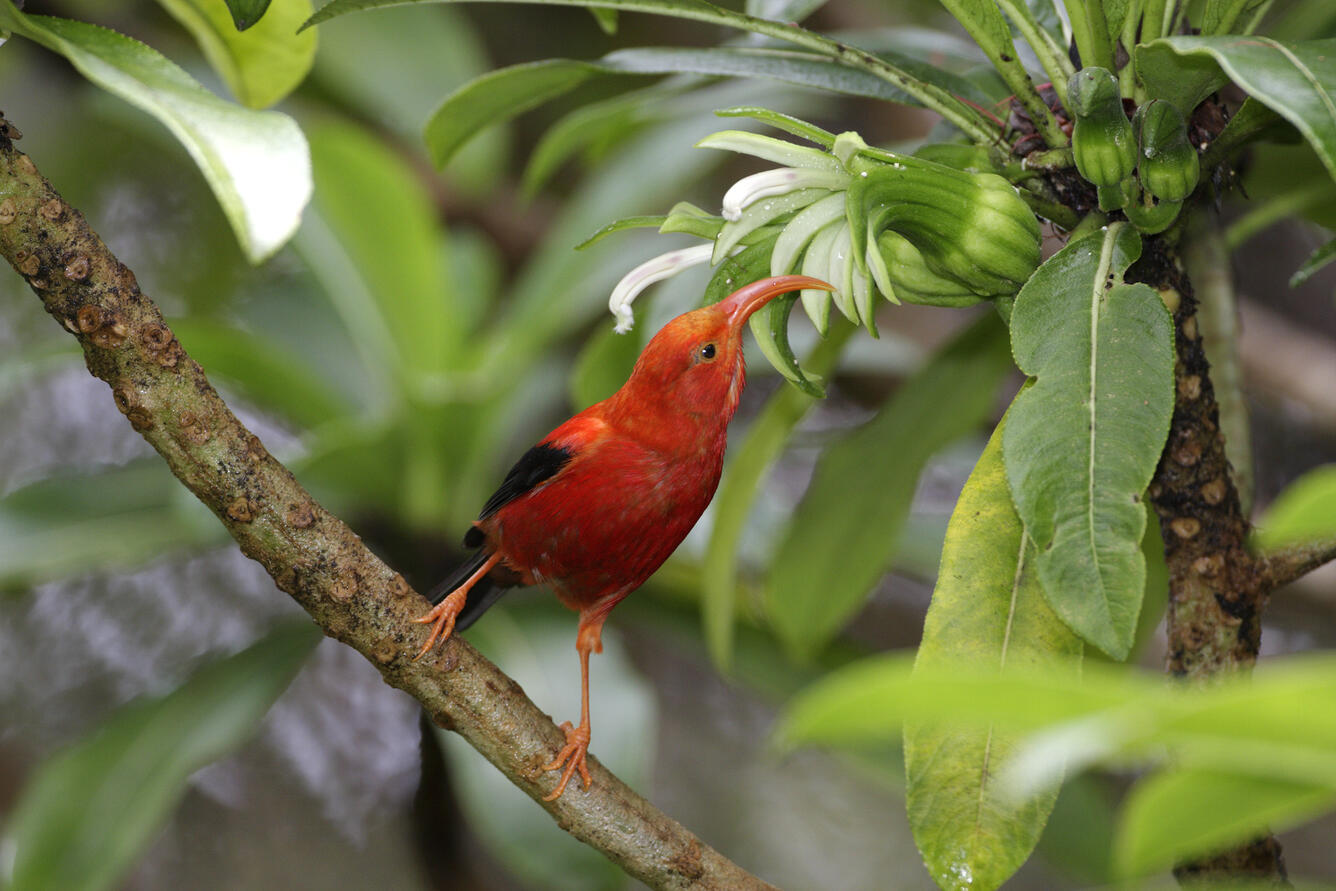Birds, Not Mosquitoes, a coalition of over a dozen federal and state conservation partners, including the Kauaʻi and Maui Forest Bird Recovery Projects, have been using a method called the incompatible insect technique to protect forest birds. The recent deployment of thousands of male mosquitoes from helicopters, for example, could be a crucial step in preserving the Hawaiian honeycreepers, a group of endemic endangered forest birds.
There were once more than 50 different species of honeycreepers spanning across the archipelago. Due to an amalgamation of disease, predation, and habitat loss, only 17 honeycreepers remain to date, with 11 of them classified as endangered or threatened. Southern house mosquitoes carrying avian malaria are among one of their most harrowing threats. A single bite can be fatal for some of these species.
The incompatible insect technique aims to suppress the mosquito population to give the honeycreepers a fighting chance. It uses the Wolbachia bacteria, naturally present in mosquitoes and other insects, to target the southern house mosquito, Culex quinquefasciatus, known for transmitting avian malaria. Incompatible Wolbachia strains can disrupt mosquito reproduction.
The released mosquitoes will mate with the wild females carrying an incompatible Wolbachia strain, resulting in nonviable offspring and a consequent decline in the mosquito population. All of the mosquitoes being released in the project are males, which, unlike their female counterparts, do not bite and do not spread diseases to humans or animals.
The Birds, Not Mosquitoes initiative is currently prioritizing efforts on Kauaʻi and Maui due to the dire endangered status of their honeycreepers. Meanwhile, the Big Island is in the process of developing their Environmental Assessment to enable similar releases across various forest bird habitats, said Bryn Webber, Mosquito Research Coordinator of the Kauaʻi Forest Bird Recovery Project.
“Kiwikiu and ‘ākohekohe are our most critically endangered honeycreepers on Maui, along with the ‘akikiki and ‘akeke‘e of Kauaʻi, they are considered to be hanging on by a thread and could go extinct in the shortest amount of time,” said Rachel Kingsley, Maui Forest Bird Recovery Project’s outreach and education associate.
Beginning in November 2023, male mosquitoes reared in laboratories were aerially deployed using biodegradable pods into Maui’s endangered forest bird habitats. Currently, 500,000 treated mosquitoes are being released every week over a specific 3,000 acre region in East Maui, according to the National Parks Service.
“Sadly the situation on Kauaʻi is pretty dire,” Webber said. “It’s kind of a race against time right now.”
Kauaʻi ran two initial small-scale releases called “Mark, Release, Recapture,” deploying around 20,000 mosquitoes in October and around 16,000 mosquitoes in December of 2023. The objective of these trial releases was to study how far along the landscape these mosquitoes were traveling and how long they were living. This mosquito trapping data is fed into complex spatial environmental models which is used to estimate the population of the mosquitoes and predict how many need to be released for effective results.
“This helps us determine how many mosquitoes we release,” Webber said, “how far apart we need to release them, and how often we need to release them.”
Monitoring occurred for nine days at each location, with follow-up monitoring conducted six weeks after the initial releases.
“We found that the males aren’t moving quite as far as we anticipated,” Webber said. “But they’re actually living slightly longer than we thought they would.”
While the exact start date for landscape level mosquito releases on Kauai is yet to be confirmed, Webber anticipates it will commence in the fall of this year.
Climate change is exacerbating the threat to honeycreepers by expanding the habitat range of mosquitoes.
“There once was this kind of imaginary line on our islands where there weren’t mosquitoes above about 4,000 feet in elevation because it was too cool for them to carry on their lifecycle,” Kingsley said. “But as the climate is changing and warming, unfortunately, that imaginary line no longer exists, and we’re seeing mosquitoes reaching heights of up to 6,000 feet in elevation.”
The four Hawaiian honeycreepers of particular concern – ‘akikiki, ‘akeke‘e, ‘ākohekohe and kiwikiu – could possibly go extinct within the next 10 years without substantial conservation efforts. For the scarlet Hawaiian honeycreeper known as ʻiʻiwi, which has been classified as a threatened species under the Endangered Species Act, there is a 90% chance of death from one infected mosquito bite.
“We have eight forest bird species on Kauaʻi, three of them are critically endangered, one of those, the ‘akikiki, is virtually extinct in the wild, which has been very devastating to witness,” said Webber.
“I worked as a field technician on this project years ago,” she said. “I was able to work with the ‘akikiki, monitoring that population back when there were around 400 individuals. Now there are about four.”
Honeycreepers have evolved over millions of years to fit perfectly within their niche habitat and interconnected role in Hawaiʻi’s ecosystem. These birds are crucial pollinators and seed dispersers for native plants. Unlike these uniquely adapted and endemic forest birds, mosquitoes, including Culex quinquefasciatus, are invasive and do not fulfill any known ecosystem function.
Honeycreepers are deeply intertwined with the cultural history and evolution of the Hawaiian islands, reflected in the language, stories, songs, and hulas, with their feathers revered as prized possessions.
They are often referred, Kingsley said, as the “jewels” or “kupuna” of the forests.
“Our birds found the islands as some of them were still forming,” Kingsley said, “and were evolving alongside these islands as they were coming up out of the water.”
“So they’re really the ancestors of these places,” she added. “Their voices were some of the first sounds that our landscapes were hearing.”
Funding for this project comes from a combination of sources, including federal agencies such as the US Fish and Wildlife Service and National Park Service, as well as private organizations like The Nature Conservancy and American Bird Conservancy. For example, $16 million was committed to protecting the forest birds by the US Department of the Interior last year, and a supplemental $3 million, announced by the Hawaiian Forest Bird Keystone Initiative, is en route following the adoption of a final Environmental Assessment in March. This follows a proclamation from Gov. Josh Green declaring 2024 as “Makahiki O Nā Manu Nahele: Year of the Forest Birds.”
“The Hawaiian islands are bird islands,” said Green during the signing ceremony at the Hawaii State Capitol. “Our native forest birds are fundamental to who we are.”
Despite some setbacks, Webber said she is optimistic about the collaborative honeycreeper conservation efforts and the impacts they will yield on the population.
“Hopefully, in the next few years, we could start to see our bird population rebounding,” Webber said. “It will take some time to see this, it’s not going to be immediate. We have to wait for the birds to nest and have babies, and for those babies to have babies. So it’s going to take a while to show in the numbers. But I think within a couple of years we are going to be able to just start noticing more of these honeycreepers.”







